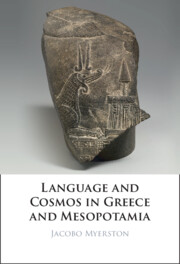Book contents
- Language and Cosmos in Greece and Mesopotamia
- Language and Cosmos in Greece and Mesopotamia
- Copyright page
- Dedication
- Contents
- Tables
- Acknowledgements
- Abbreviations
- Introduction
- 1 Babylonian Theories of Language
- 2 Language and Cosmos in the Epic of Creation
- 3 Hesiod, Language, and the Names of Ishtar
- 4 Orpheus’ Cosmic Names
- Conclusion
- Bibliography
- Index
1 - Babylonian Theories of Language
Published online by Cambridge University Press: 16 May 2023
- Language and Cosmos in Greece and Mesopotamia
- Language and Cosmos in Greece and Mesopotamia
- Copyright page
- Dedication
- Contents
- Tables
- Acknowledgements
- Abbreviations
- Introduction
- 1 Babylonian Theories of Language
- 2 Language and Cosmos in the Epic of Creation
- 3 Hesiod, Language, and the Names of Ishtar
- 4 Orpheus’ Cosmic Names
- Conclusion
- Bibliography
- Index
Summary
This chapter surveys cuneiform texts that reflect various degrees of linguistic awareness, providing the reader with a general perspective on Babylonian semiotics and linguistics. The chapter begins with a discussion of the scholarly settings in which cuneiform developed and goes on to explore how this writing system, together with practices of divination and magic, influenced the linguistic consciousness of scribes. It examines a variety of texts, including the basic elementary school exercise SA A, which Assyro-Babylonian scholars often interpreted as an esoteric text describing the very first human words. It also investigates the conceptions of language in epic narratives such Adapa and the South Wind and Gilgamesh.
Keywords
- Type
- Chapter
- Information
- Language and Cosmos in Greece and Mesopotamia , pp. 15 - 42Publisher: Cambridge University PressPrint publication year: 2023
- 1
- Cited by

